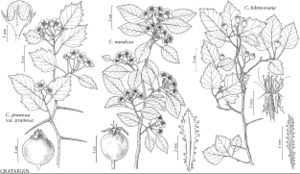Crataegus biltmoreana
Bot. Gaz. 28: 406. 1899.
Shrubs, 20–30 dm. Stems: twigs: new growth reddish, tomentose, 1-year old dark gray, 2-years old gray; thorns on twigs straight to slightly recurved, 2-years old shiny black, slender, 3–5 cm. Leaves: petiole length 40–45% blade, sometimes winged, pubescent, strongly glandular; blade narrowly to broadly ovate, 4–7 cm, base cuneate, lobes 3–5 per side, distinct, lobe apex acute, margins strongly serrate, teeth gland-tipped, veins 4 or 5 per side, apex acute, surfaces pilose (abaxial more sparsely) young, veins pilose. Inflorescences 2–7-flowered; branches tomentose; bracteoles oblong-linear, margins short-stipitate-glandular. Flowers 15–20 mm diam.; hypanthium usually densely tomentose; sepals lanceolate, 7 mm, margins deeply glandular-serrate, abaxially pilose; stamens 5–10, anthers cream; styles 3–5. Pomes yellow to orange, often with red cheek, suborbicular, 9–14 mm diam., hairy; sepals on collar, reflexed-patent, 8–9 mm; pyrenes 3–5. 2n = 51.
Phenology: Flowering Apr, May; fruiting Sep–Oct.
Habitat: Understory of open woodlands, montane coves, ridge tops
Elevation: 0–300 m
Distribution

Ala., Ark., Conn., Ga., Ind., Md., Mass., N.Y., N.C., Ohio, Pa., Tenn., Vt., Va., W.Va.
Discussion
Crataegus biltmoreana is wide-ranging but somewhat scarce; it is known from Vermont to Georgia and west to Missouri and Arkansas, but is most abundant in Appalachia.
Crataegus biltmoreana is distinctive with its very hairy young twigs, leaves, and inflorescence branches, low stature, long thorns, large flowers, and yellow to orange pomes. Indumentum is the only consistent difference from C. intricata; specific rank is maintained because wide-ranging glabrous/hairy variants of one species are so unusual in North American Crataegus. Eventually, it may prove better to accept C. biltmoreana as a variety of that species. Rare forms with almost unlobed leaves, the sinuses shallow and lobes obtuse when present, may be the same.
Selected References
None.
